check engine RENAULT TWIZY 2017 1.G Owners Manual
[x] Cancel search | Manufacturer: RENAULT, Model Year: 2017, Model line: TWIZY, Model: RENAULT TWIZY 2017 1.GPages: 118, PDF Size: 2.48 MB
Page 11 of 118
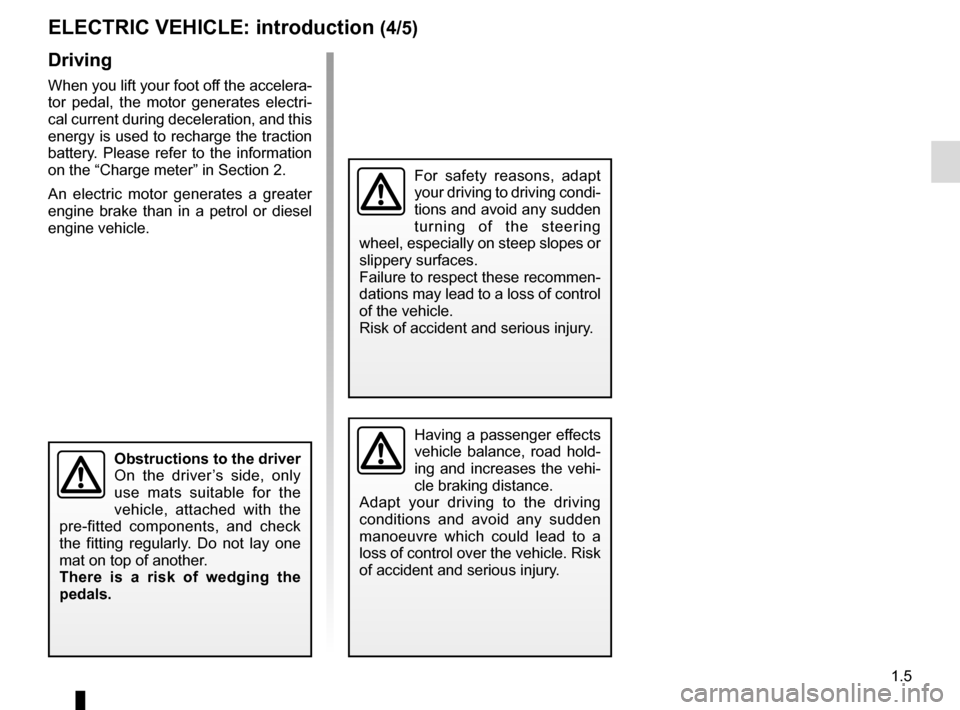
1.5
ELECTRIC VEHICLE: introduction (4/5)
For safety reasons, adapt
your driving to driving condi-
tions and avoid any sudden
turning of the steering
wheel, especially on steep slopes or
slippery surfaces.
Failure to respect these recommen-
dations may lead to a loss of control
of the vehicle.
Risk of accident and serious injury.
Obstructions to the driver
On the driver’s side, only
use mats suitable for the
vehicle, attached with the
pre-fitted components, and check
the fitting regularly. Do not lay one
mat on top of another.
There is a risk of wedging the
pedals.
Having a passenger effects
vehicle balance, road hold-
ing and increases the vehi-
cle braking distance.
Adapt your driving to the driving
conditions and avoid any sudden
manoeuvre which could lead to a
loss of control over the vehicle. Risk
of accident and serious injury.
Driving
When you lift your foot off the accelera-
tor pedal, the motor generates electri-
cal current during deceleration, and this
energy is used to recharge the traction
battery. Please refer to the information
on the “Charge meter” in Section 2.
An electric motor generates a greater
engine brake than in a petrol or diesel
engine vehicle.
Page 29 of 118
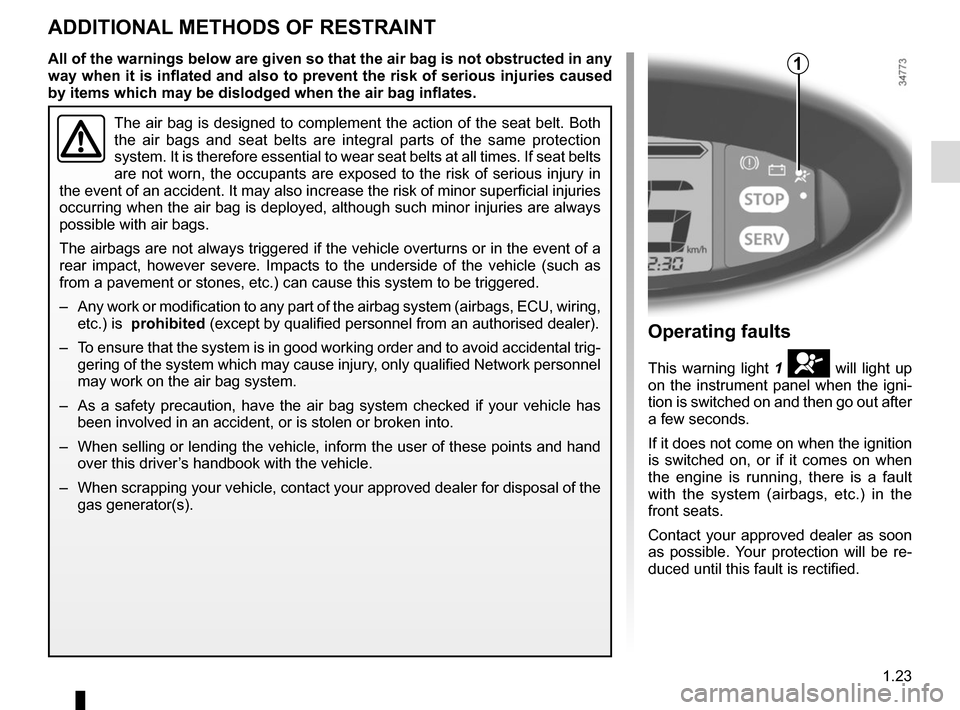
1.23
ADDITIONAL METHODS OF RESTRAINT
The air bag is designed to complement the action of the seat belt. Both \
the air bags and seat belts are integral parts of the same protection
system. It is therefore essential to wear seat belts at all times. If se\
at belts
are not worn, the occupants are exposed to the risk of serious injury in\
the event of an accident. It may also increase the risk of minor superfi\
cial injuries
occurring when the air bag is deployed, although such minor injuries are\
always
possible with air bags.
The airbags are not always triggered if the vehicle overturns or in the \
event of a
rear impact, however severe. Impacts to the underside of the vehicle (s\
uch as
from a pavement or stones, etc.) can cause this system to be triggered.\
– Any work or modification to any part of the airbag system (airbags, ECU\
, wiring, etc.) is prohibited (except by qualified personnel from an authorised dealer).
– To ensure that the system is in good working order and to avoid accidenta\
l trig- gering of the system which may cause injury, only qualified Network personnel
may work on the air bag system.
– As a safety precaution, have the air bag system checked if your vehicle \
has been involved in an accident, or is stolen or broken into.
– When selling or lending the vehicle, inform the user of these points and\
hand over this driver’s handbook with the vehicle.
– When scrapping your vehicle, contact your approved dealer for disposal o\
f the gas generator(s).
Operating faults
This warning light 1 å will light up
on the instrument panel when the igni-
tion is switched on and then go out after
a few seconds.
If it does not come on when the ignition
is switched on, or if it comes on when
the engine is running, there is a fault
with the system (airbags, etc.) in the
front seats.
Contact your approved dealer as soon
as possible. Your protection will be re-
duced until this fault is rectified.
1All of the warnings below are given so that the air bag is not obstructed in any
way when it is inflated and also to prevent the risk of serious injuries caused
by items which may be dislodged when the air bag inflates.
Page 30 of 118
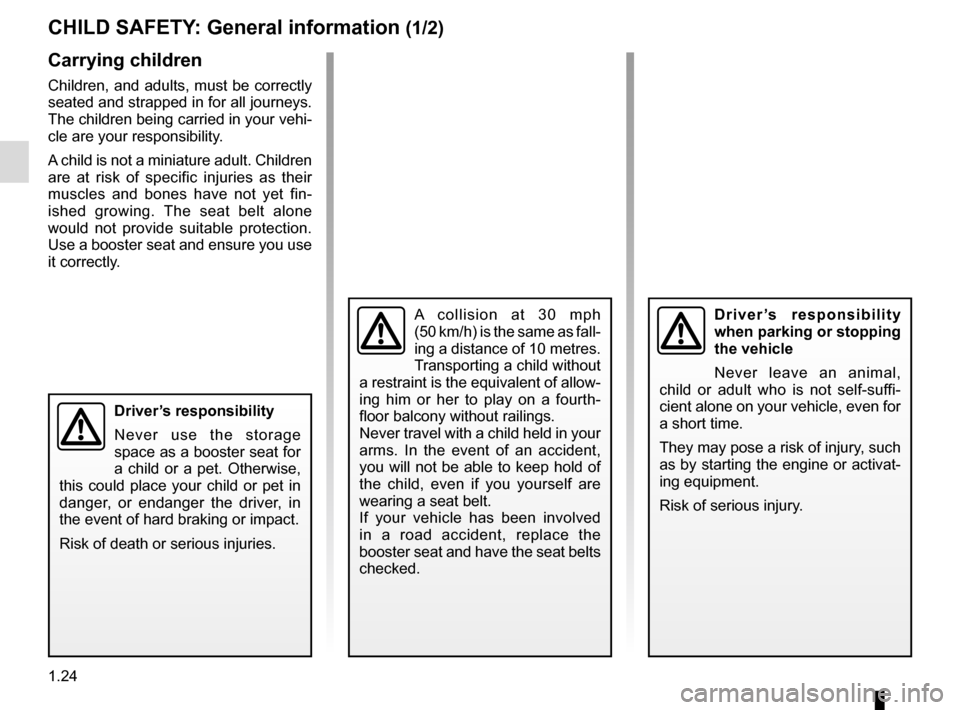
1.24
CHILD SAFETY: General information (1/2)
Carrying children
Children, and adults, must be correctly
seated and strapped in for all journeys.
The children being carried in your vehi-
cle are your responsibility.
A child is not a miniature adult. Children
are at risk of specific injuries as their
muscles and bones have not yet fin-
ished growing. The seat belt alone
would not provide suitable protection.
Use a booster seat and ensure you use
it correctly.
A collision at 30 mph
(50 km/h) is the same as fall-
ing a distance of 10 metres.
Transporting a child without
a restraint is the equivalent of allow-
ing him or her to play on a fourth-
floor balcony without railings.
Never travel with a child held in your
arms. In the event of an accident,
you will not be able to keep hold of
the child, even if you yourself are
wearing a seat belt.
If your vehicle has been involved
in a road accident, replace the
booster seat and have the seat belts
checked.Driver’s responsibility
when parking or stopping
the vehicle
Never leave an animal,
child or adult who is not self-suffi-
cient alone on your vehicle, even for
a short time.
They may pose a risk of injury, such
as by starting the engine or activat-
ing equipment.
Risk of serious injury.
Driver’s responsibility
Never use the storage
space as a booster seat for
a child or a pet. Otherwise,
this could place your child or pet in
danger, or endanger the driver, in
the event of hard braking or impact.
Risk of death or serious injuries.
Page 51 of 118
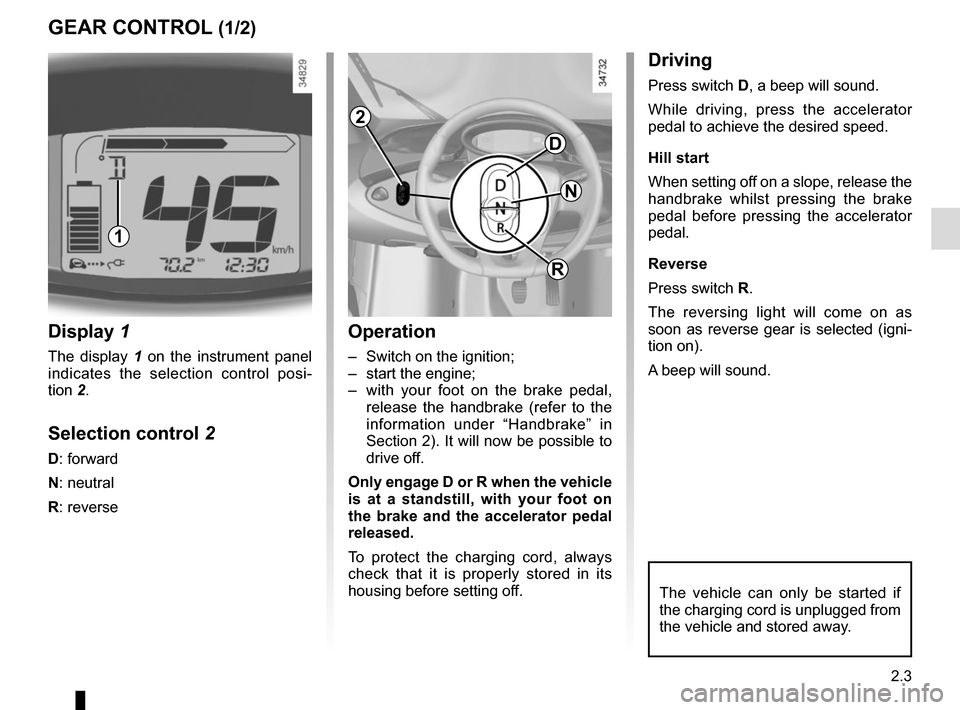
2.3
Driving
Press switch D, a beep will sound.
While driving, press the accelerator
pedal to achieve the desired speed.
Hill start
When setting off on a slope, release the
handbrake whilst pressing the brake
pedal before pressing the accelerator
pedal.
Reverse
Press switch R.
The reversing light will come on as
soon as reverse gear is selected (igni-
tion on).
A beep will sound.
GEAR CONTROL (1/2)
Display 1
The display 1 on the instrument panel
indicates the selection control posi-
tion 2.
Selection control 2
D: forward
N: neutral
R: reverse
Operation
– Switch on the ignition;
– start the engine;
– with your foot on the brake pedal,
release the handbrake (refer to the
information under “Handbrake” in
Section 2). It will now be possible to
drive off.
Only engage D or R when the vehicle
is at a standstill, with your foot on
the brake and the accelerator pedal
released.
To protect the charging cord, always
check that it is properly stored in its
housing before setting off.
The vehicle can only be started if
the charging cord is unplugged from
the vehicle and stored away.
1
D
N
R
2
Page 52 of 118
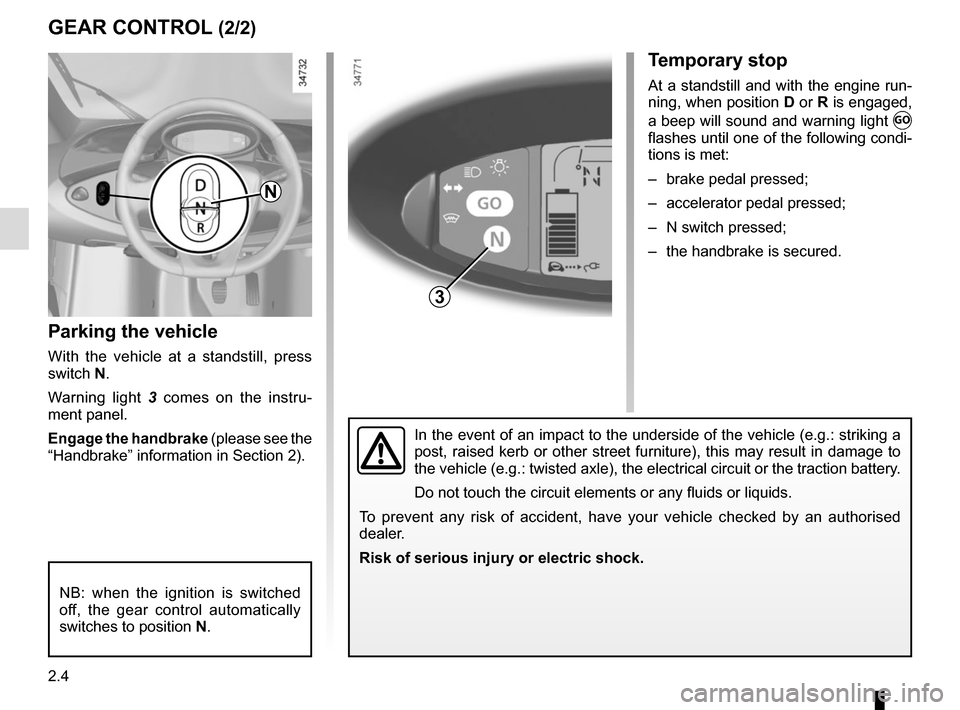
2.4
Parking the vehicle
With the vehicle at a standstill, press
switch N.
Warning light 3 comes on the instru-
ment panel.
Engage the handbrake (please see the
“Handbrake” information in Section 2).
GEAR CONTROL (2/2)
In the event of an impact to the underside of the vehicle (e.g.: striki\
ng a
post, raised kerb or other street furniture), this may result in damage\
to
the vehicle (e.g.: twisted axle), the electrical circuit or the tracti\
on battery.
Do not touch the circuit elements or any fluids or liquids.
To prevent any risk of accident, have your vehicle checked by an authoris\
ed
dealer.
Risk of serious injury or electric shock.
N
3
NB: when the ignition is switched
off, the gear control automatically
switches to position N.
Temporary stop
At a standstill and with the engine run-
ning, when position D or R is engaged,
a beep will sound and warning light
Ṑ
flashes until one of the following condi-
tions is met:
– brake pedal pressed;
– accelerator pedal pressed;
– N switch pressed;
– the handbrake is secured.
Page 87 of 118
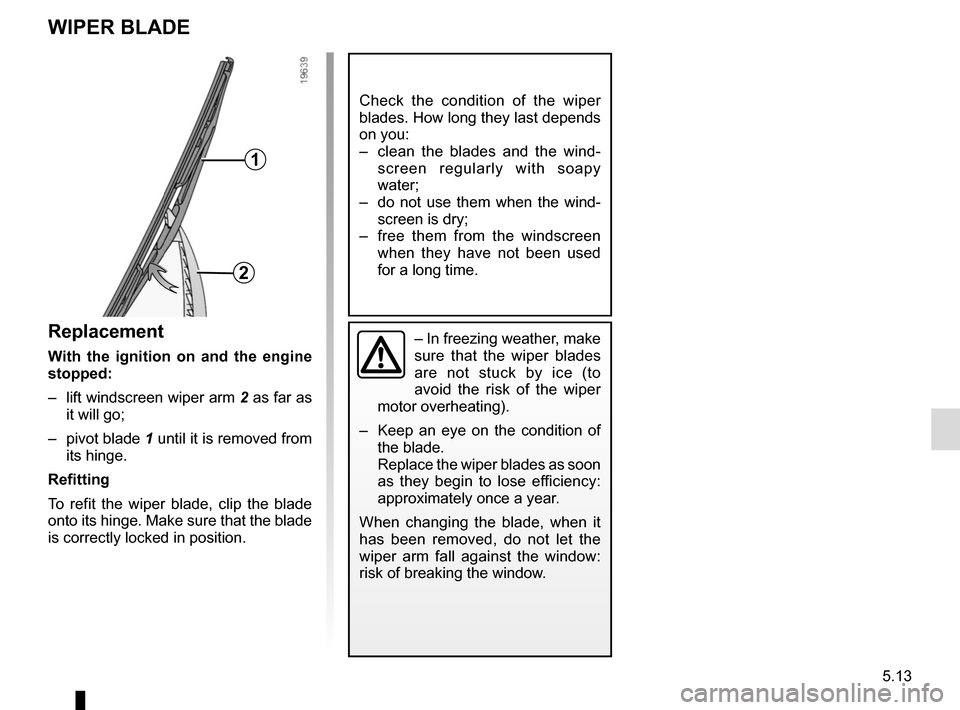
5.13
WIPER BLADE
Check the condition of the wiper
blades. How long they last depends
on you:
– clean the blades and the wind-screen regularly with soapy
water;
– do not use them when the wind- screen is dry;
– free them from the windscreen when they have not been used
for a long time.
– In freezing weather, make
sure that the wiper blades
are not stuck by ice (to
avoid the risk of the wiper
motor overheating).
– Keep an eye on the condition of
the blade.
Replace the wiper blades as soon
as they begin to lose efficiency:
approximately once a year.
When changing the blade, when it
has been removed, do not let the
wiper arm fall against the window:
risk of breaking the window.Replacement
With the ignition on and the engine
stopped:
– lift windscreen wiper arm 2 as far as
it will go;
– pivot blade 1 until it is removed from
its hinge.
Refitting
To refit the wiper blade, clip the blade
onto its hinge. Make sure that the blade
is correctly locked in position.
1
2
Page 91 of 118
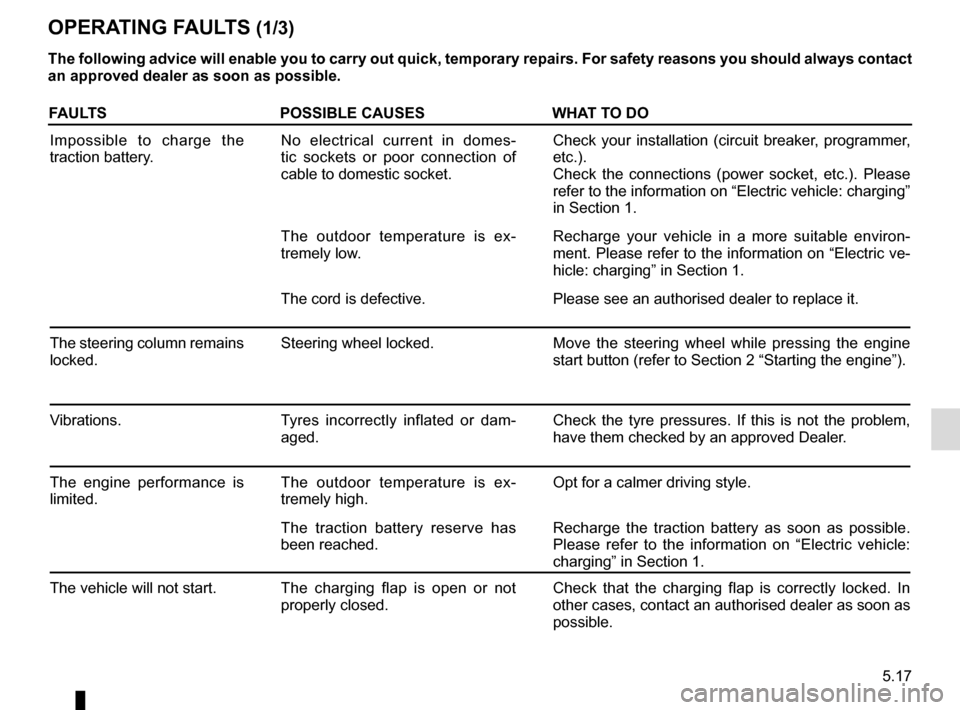
5.17
OPERATING FAULTS (1/3)
The following advice will enable you to carry out quick, temporary repai\
rs. For safety reasons you should always contact
an approved dealer as soon as possible.
FAULTSPOSSIBLE CAUSES WHAT TO DO
Impossible to charge the
traction battery. No electrical current in domes-
tic sockets or poor connection of
cable to domestic socket. Check your installation (circuit breaker, programmer,
etc.).
Check the connections (power socket, etc.). Please
refer to the information on “Electric vehicle: charging”
in Section 1.
The outdoor temperature is ex-
tremely low. Recharge your vehicle in a more suitable environ-
ment. Please refer to the information on “Electric ve-
hicle: charging” in Section 1.
The cord is defective. Please see an authorised dealer to replace it.
The steering column remains
locked. Steering wheel locked.
Move the steering wheel while pressing the engine
start button (refer to Section 2 “Starting the engine”).
Vibrations. Tyres incorrectly inflated or dam-
aged. Check the tyre pressures. If this is not the problem,
have them checked by an approved Dealer.
The engine performance is
limited. The outdoor temperature is ex-
tremely high. Opt for a calmer driving style.
The traction battery reserve has
been reached. Recharge the traction battery as soon as possible.
Please refer to the information on “Electric vehicle:
charging” in Section 1.
The vehicle will not start. The charging flap is open or not
properly closed. Check that the charging flap is correctly locked. In
other cases, contact an authorised dealer as soon as
possible.
Page 95 of 118
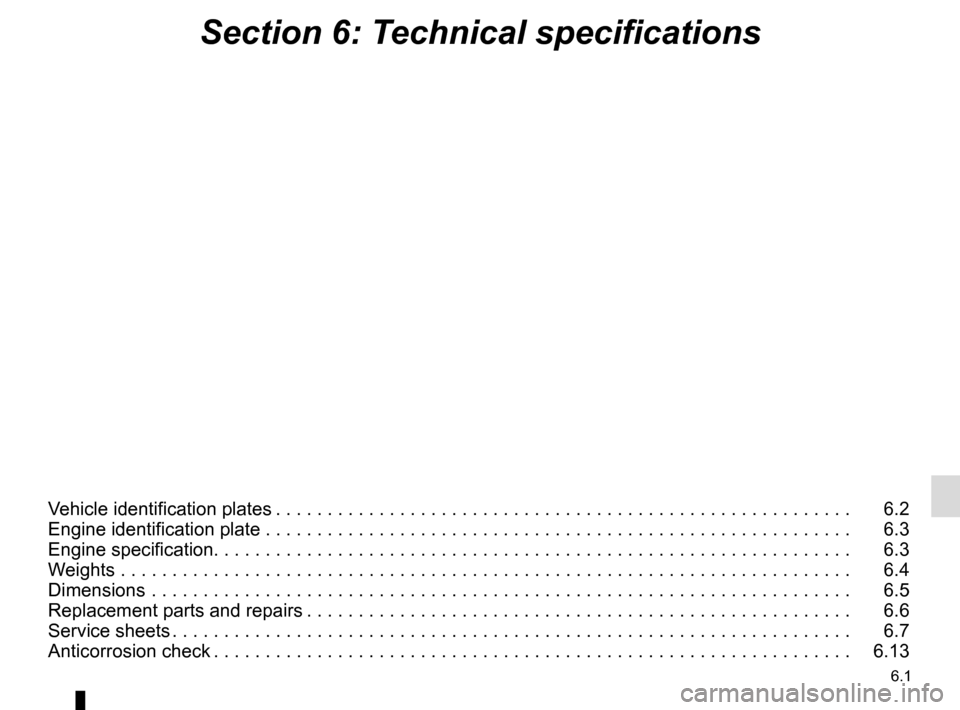
6.1
Section 6: Technical specifications
Vehicle identification plates . . . . . . . . . . . . . . . . . . . . . . . . . . . . . . . . . . . . \
. . . . . . . . . . . . . . . . . . . . 6.2
Engine identification plate . . . . . . . . . . . . . . . . . . . . . . . . . . . . . . . . . . . .\
. . . . . . . . . . . . . . . . . . . . . 6.3
Engine specification. . . . . . . . . . . . . . . . . . . . . . . . . . . . . . . . . . . . \
. . . . . . . . . . . . . . . . . . . . . . . . . . 6.3
Weights . . . . . . . . . . . . . . . . . . . . . . . . . . . . . . . . . . . .\
. . . . . . . . . . . . . . . . . . . . . . . . . . . . . . . . . . . 6.4
Dimensions . . . . . . . . . . . . . . . . . . . . . . . . . . . . . . . . . . . .\
. . . . . . . . . . . . . . . . . . . . . . . . . . . . . . . . 6.5
Replacement parts and repairs . . . . . . . . . . . . . . . . . . . . . . . . . . . . . . . . . . . . \
. . . . . . . . . . . . . . . . . 6.6
Service sheets . . . . . . . . . . . . . . . . . . . . . . . . . . . . . . . . . . . . \
. . . . . . . . . . . . . . . . . . . . . . . . . . . . . . 6.7
Anticorrosion check . . . . . . . . . . . . . . . . . . . . . . . . . . . . . . . . . . . . \
. . . . . . . . . . . . . . . . . . . . . . . . . . 6.13
Page 113 of 118
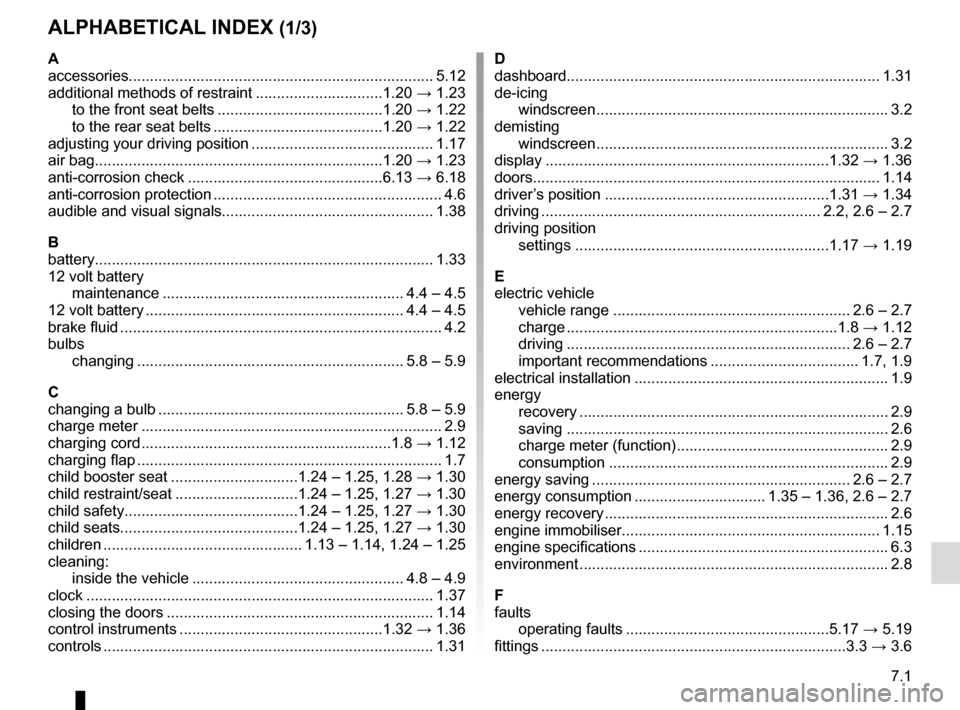
7.1
ALPHABETICAL INDEX (1/3)
A
accessories........................................................................\
5.12
additional methods of restraint ..............................1.20 → 1.23
to the front seat belts .......................................1.20 → 1.22
to the rear seat belts ........................................1.20 → 1.22
adjusting your driving position ........................................... 1.17
air bag....................................................................1.20 → 1.23
anti-corrosion check ..............................................6.13 → 6.18
anti-corrosion protection ...................................................... 4.6
audible and visual signals.................................................. 1.38
B
battery........................................................................\
........ 1.33
12 volt battery maintenance ......................................................... 4.4 – 4.5
12 volt battery ............................................................. 4.4 – 4.5
brake fluid ........................................................................\
.... 4.2
bulbs changing ............................................................... 5.8 – 5.9
C
changing a bulb .......................................................... 5.8 – 5.9
charge meter ....................................................................... 2.9
charging cord ...........................................................1.8 → 1.12
charging flap ........................................................................\
1.7
child booster seat ..............................1.24 – 1.25, 1.28 → 1.30
child restraint/seat .............................1.24 – 1.25, 1.27 → 1.30
child safety.........................................1.24 – 1.25, 1.27 → 1.30
child seats..........................................1.24 – 1.25, 1.27 → 1.30
children ............................................... 1.13 – 1.14, 1.24 – 1.25
cleaning: inside the vehicle .................................................. 4.8 – 4.9
clock ..................................................................\
................ 1.37
closing the doors ............................................................... 1.14
control instruments ................................................1.32 → 1.36
controls ...............................................................\
............... 1.31 D
dashboard........................................................................\
.. 1.31
de-icing windscreen .............................................................\
........ 3.2
demisting windscreen .............................................................\
........ 3.2
display ................................................................\
...1.32 → 1.36
doors........................................................................\
.......... 1.14
driver’s position .....................................................1.31 → 1.34
driving .................................................................. 2.2, 2.6 – 2.7
driving position settings ............................................................1.17 → 1.19
E
electric vehicle vehicle range ........................................................ 2.6 – 2.7
charge ................................................................1.8 → 1.12
driving ................................................................... 2.6 – 2.7
important recommendations ................................... 1.7, 1.9
electrical installation ............................................................ 1.9
energy recovery ...............................................................\
.......... 2.9
saving .................................................................\
........... 2.6
charge meter (function) .................................................. 2.9
consumption ............................................................\
...... 2.9
energy saving ............................................................. 2.6 – 2.7
energy consumption ............................... 1.35 – 1.36, 2.6 – 2.7
energy recovery ................................................................... 2.6
engine immobiliser............................................................. 1.15
engine specifications ........................................................... 6.3
environment ............................................................\
............. 2.8
F
faults operating faults ................................................5.17 → 5.19
fittings ...............................................................\
.........3.3 → 3.6